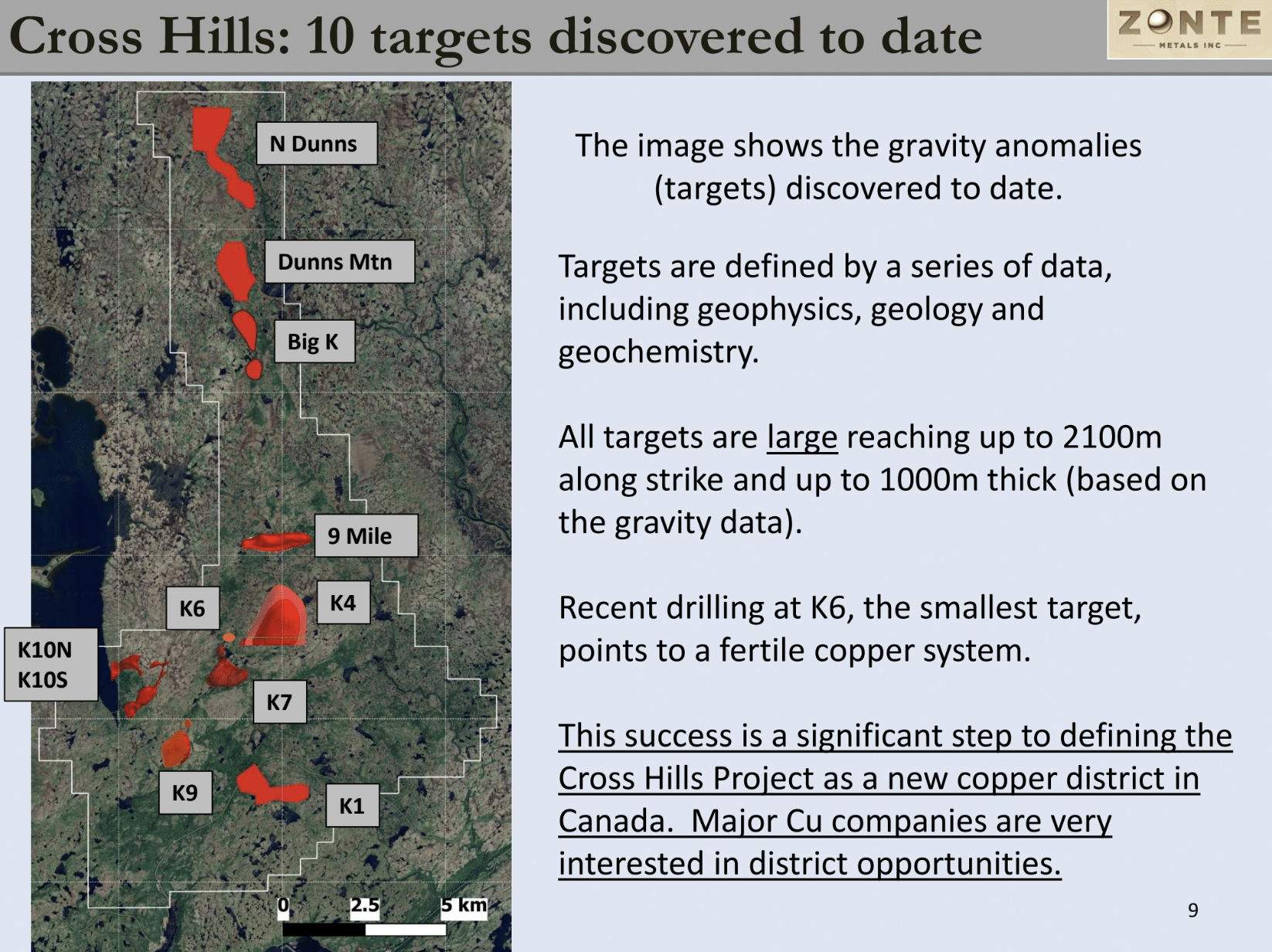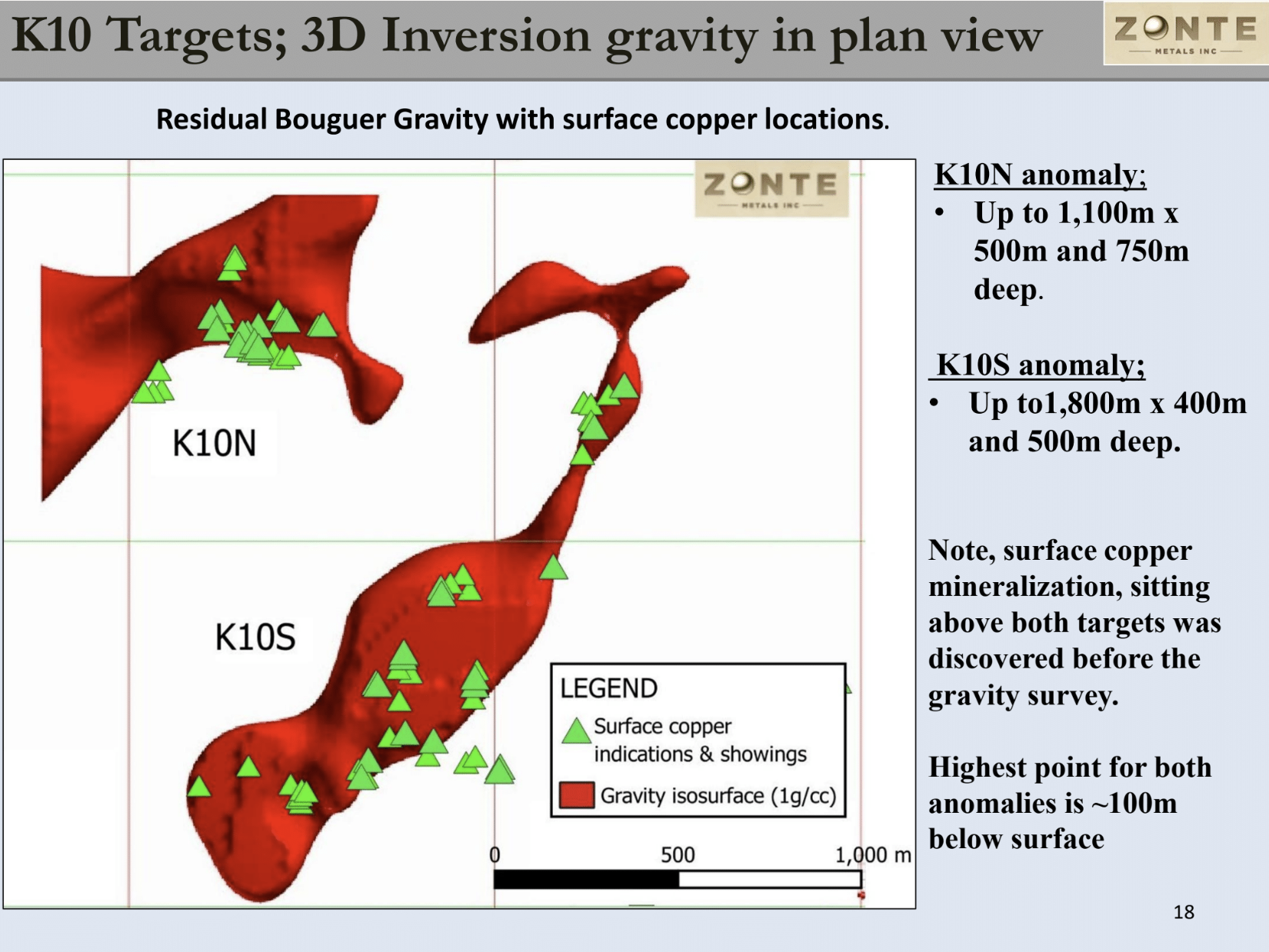Zonte Metals Validates IOCG Model at K6, Advances Targets Comparable to Major Global Deposits
.jpg)
Zonte Metals advances 9 drill-ready IOCG copper targets in Newfoundland after K6 discovery validates exploration model. Large-scale tonnage potential in Tier-1 jurisdiction.
- Zonte Metals has been systematically exploring the Cross Hills Copper Project for seven years, transforming it from grassroots exploration into an advanced play with nine drill-ready targets across 14,000 hectares.
- The company achieved proof-of-concept in 2023-2024, discovering copper mineralization at the K6 target using integrated geophysical and geochemical techniques, validating their exploration methodology.
- Nine gravity anomalies remain largely undrilled, with some comparable in scale to major IOCG deposits like Prominent Hill (300 million tons) and La Calenderia (700 million tons).
- The company integrates ground gravity, magnetics, structural analysis, and multiple soil geochemistry techniques to identify redox boundaries and density contrasts characteristic of IOCG systems.
- Located in a mining-friendly jurisdiction (ranked 6th globally by Fraser Institute), with tidewater access, hydroelectric power, and paved road infrastructure supporting future development.
As copper prices return above $5 per pound, junior exploration companies with large-scale targets in stable jurisdictions are attracting renewed attention. Zonte Metals, led by President and CEO Dr. Terry Christopher, represents an emerging opportunity in Newfoundland's eastern geological terrain - a region historically overlooked for copper potential but now yielding evidence of iron-oxide-copper-gold (IOCG) mineralisation. After seven years of methodical exploration work, the company has advanced its Cross Hills Copper Project from grassroots concept to an advanced exploration play with multiple drill-ready targets and proven mineralization.
Background: A Geochemist's Approach to IOCG Systems
Dr. Terry Christopher brings over 30 years of industry experience to Zonte Metals, including successful discoveries in Mexico where he was involved in finding gold deposits in 2004 and 2009. With a PhD in geochemistry, Christopher has been running Zonte Metals since 2010, initially as a Capital Pool Company while searching for opportunities in large-scale hydrothermal systems. His technical background proves particularly relevant for IOCG exploration, which requires understanding complex geochemical signatures and alteration patterns.
The Geological Setting: Understanding Newfoundland's Copper Terrain
Newfoundland consists of three distinct geological terrains, each with different mineralization potential. While most investors associate the province with gold deposits in the central Gander Belt - home to New Found Gold's significant discovery - Zonte operates in the eastern portion of the island where copper systems dominate. This area was identified by the Geological Survey of Canada in 2007 as having IOCG potential, though systematic exploration had not been undertaken until Zonte's arrival.
"The area is known for IOCG mineralization or style of mineralization. We're the first company to go in there and systematically explore this."
The company operates in a region with documented sedex mineralization and IOCG signatures, providing geological validation for their exploration thesis.
Methodical Exploration: Building a Multi-Layer Dataset
Zonte's exploration strategy reflects Christopher's scientific background, prioritising comprehensive surface data collection before committing significant capital to drilling. The first two years focused on ground magnetic and gravity surveys, identifying anomalies that could indicate dense mineralised bodies at depth. Initial drilling on one target yielded encouraging high-grade intercepts - 14% copper over 0.5 meters with 0.5 ounces of gold and 350 grams of silver - confirming the system's fertility even without discovering an economic deposit.
Rather than immediately pursuing aggressive drilling campaigns, the company spent years three through five conducting additional surface work to better understand the hydrothermal system. This included ground gravity surveys, magnetics, alteration mapping, structural analysis, and multiple soil geochemistry techniques.
"The idea here was through those years let's get as much data as we can from surface work so that we have a better probability of hitting copper in the drill bit."
Interview with Dr. Terry Christopher, CEO, Zonte Metals
The K6 Discovery: Validation of the Exploration Model
In late 2023 and summer 2024, Zonte tested their integrated dataset at the K6 target - described as their smallest target. The drilling successfully intersected copper mineralization, validating the exploration methodology. The K6 target revealed a structural zone with bornite and calcite mineralization extending to approximately 170 meters depth, with the upper 100 meters dominated by chalcopyrite before transitioning to a mixture of calcite and bornite.
The K6 results proved particularly valuable for refining future exploration. Post-drilling analysis allowed the company to eliminate certain techniques that didn't work (partial leaf soils, conventional soils, and IP surveys) while confirming the effectiveness of gravity, magnetics, structural analysis, and specific soil geochemistry methods. This data distillation process now guides targeting for the nine remaining prospects.
"K6 was proof that we're in a fertile copper system. If we hadn't hit on K6 then that would have changed the property."
Technical Approach: Identifying Redox Boundaries and Structural Controls
The company's targeting strategy centers on identifying redox (oxidation-reduction) boundaries - critical zones where geochemical conditions favour copper precipitation in IOCG systems. This involves analysing subtle changes in magnetic signatures associated with gravity anomalies and geochemical indicators suggesting redox transitions. The company then correlates these signatures with structural analysis to identify potential sites where mineralization could accumulate, particularly in strike-slip fault environments.
Structural controls play a significant role in the company's model. Satellite structural analysis identified two distinct structural terrains across the property: strike-slip faulting in the southern portion and a graben system in the north. Evidence of fault reactivation through different time periods suggests enhanced fluid flow pathways—a positive indicator for mineralization.
When asked about redox signatures, Christopher revealed:
"Our whole basis is to look for the redox change and that will give us hopefully the location where copper would have precipitated. We see it in geo-chem, see it in the geophysics and then trace it back to the structurals."
The Target Portfolio: Nine Drill-Ready Prospects
Zonte's property hosts nine gravity anomalies that have either not been drilled or require re-evaluation with updated data. These targets span a 25-kilometer land package of approximately 14,000 hectares. A 5-kilometer scale bar on the company's targeting maps illustrates the significant size of these anomalies - dimensions comparable to major IOCG deposits globally.

The K10 target exemplifies the company's integrated approach. Surface mapping identified copper mineralization at multiple locations, represented by green triangles on the company's maps. When gravity surveys were subsequently completed, the surface copper occurrences aligned directly above gravity anomalies located approximately 100 meters below surface - precisely the depth where drilling at both Dunns Mountain and K6 began encountering mineralization.

Seven targets are currently drill-ready, with two requiring minor infill work on gravity and soils. The company is fully permitted for winter drilling on the K9 target in the southern portion of the property. The K4 target presents particular interest due to its strong gravity signature and deeper setting, prompting additional fieldwork to develop an appropriate drilling model.
Deposit-Scale Potential: Benchmarking Against Global IOCG Systems
IOCG deposits are characterised by their large tonnage potential and polymetallic nature. Christopher referenced three benchmark deposits to frame investor expectations: Olympic Dam (the world's most famous IOCG), Prominent Hill in Australia (just under 300 million tons at 0.9% copper with 0.8 grams per ton gold), and La Calenderia in Chile (just under 700 million tons at 0.5% copper).
Tonnage calculations performed on Zonte's gravity anomalies suggest comparable scale opportunities exist within their property. While the company emphasises that mineralization must be confirmed through drilling, the geophysical signatures indicate substantial volumes of dense material at depth.
Infrastructure and Jurisdiction: Reducing Development Risk
Newfoundland offers significant jurisdictional advantages. The Fraser Institute ranked the province sixth globally for mining attractiveness in 2024, reflecting stable regulations and supportive government policies. The Cross Hills project benefits from excellent infrastructure: tidewater access on the southern boundary, a power line supplying hydroelectric electricity from Labrador, and a paved road traversing the southern portion of the property. ATV access facilitates exploration across the remainder of the land package.
The hydroelectric power source adds an ESG dimension that could prove valuable in future development scenarios, particularly as copper demand increasingly derives from electrification and renewable energy applications.
Capital Strategy and Next Steps
Zonte is pursuing non-dilutive financing opportunities to fund the upcoming drill program, with management acknowledging that traditional equity financing remains an option if partnership or streaming arrangements don't materialise. The company has been conducting extensive investor education around IOCG systems, which are less familiar to some financial audiences compared to porphyry or epithermal deposits.
"We've spent a lot of time now educating people to understand our hydrothermal system, our IOCG system and it's working in terms of institutional money is now starting to get an interest in this property."
Major mining companies demonstrate familiarity with IOCG systems given their global portfolios, potentially facilitating partnership discussions as the project advances.
The Investment Thesis for Zonte Metals
- Validated IOCG System: K6 discovery confirms copper mineralization and validates the exploration model, reducing geological risk for testing the nine remaining undrilled targets.
- Large-Scale Tonnage Potential: Gravity anomalies comparable in scale to 300-700 million ton IOCG deposits globally (Prominent Hill, La Calenderia), with tonnage calculations supporting substantial mineralization potential.
- Data-Driven Targeting: Seven years of systematic surface work integrating gravity, magnetics, structural analysis, and geochemistry provides high-confidence drill targets with defined redox boundaries.
- Infrastructure Advantage: Tidewater access, hydroelectric power, paved roads, and Newfoundland's #6 global ranking for mining attractiveness significantly reduce future development risk and capital requirements.
- Portfolio Effect: Nine distinct targets provide multiple value inflection points over coming drill programs, reducing single-target dependency risk common in early-stage explorers.
- Copper Price Tailwind: With copper returning above $5/pound amid electrification demand and supply constraints, IOCG discoveries in stable jurisdictions attract premium valuations and partnership interest.
- Experienced Technical Leadership: CEO with 30+ years experience and PhD in geochemistry, with track record of discoveries in Mexico and deep understanding of IOCG systems through relationships with discoverers of deposits like Prominent Hill.
- Non-Dilutive Funding Options: Management actively pursuing partnership or alternative financing structures to minimise shareholder dilution during the drill-intensive phase ahead.
Macro Thematic Analysis
IOCG systems represent some of the world's largest copper deposits, with Olympic Dam, Prominent Hill, and La Calenderia collectively containing billions of tons of mineralization. As electrification accelerates - electric vehicles require four times the copper of combustion vehicles - large-scale, long-life copper deposits in stable jurisdictions command strategic premiums. Newfoundland's eastern geological terrain, historically underexplored for copper despite Geological Survey of Canada identification of IOCG potential in 2007, represents a rare greenfield opportunity in a Tier-1 mining jurisdiction. Unlike many copper provinces facing political risk, resource nationalism, or infrastructure deficits, Atlantic Canada offers permitting certainty, tidewater access, and hydroelectric power - critical factors as ESG considerations increasingly influence mining investment and offtake decisions.
The convergence of copper supply constraints, electrification demand, and discovery scarcity in safe jurisdictions creates a favourable backdrop for early-stage IOCG explorers with proven mineralization and large-scale targets.
TL;DR:
Zonte Metals has transformed its Cross Hills Copper Project from grassroots exploration into an advanced IOCG play through seven years of systematic data collection, achieving a proof-of-concept discovery at K6 that validates their targeting methodology. With nine drill-ready targets comparable in scale to major global IOCG deposits (300-700 million tons), excellent infrastructure, and Newfoundland's top-tier mining jurisdiction ranking, the company is entering an aggressive drill phase with multiple value inflection points. The combination of proven mineralization, large-scale tonnage potential, experienced technical leadership, and favorable copper fundamentals positions Zonte as a high-leverage opportunity in the copper exploration space.
FAQ's (AI Generated)
Analyst's Notes




Subscribe to Our Channel
Stay Informed











































